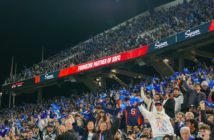It would be fair to say that David Moyes is a manager whose best work has been the product of sticking to what he knows best.
This was most obvious during his 11-year spell in charge of Everton. Budgetary restrictions and the Scotsman’s reliance on a core of reliable, experienced players throughout the squads at his disposal meant Everton were often a predictable side but nonetheless a successful one.
Moyes made Goodison Park one of the least hospitable Premier League grounds for opponents to visit. A tight pitch coupled with an often vociferous atmosphere created an environment in which a physically adept, well-drilled Everton outfit would take points from wealthier, more fashionable opponents and regularly qualified for European football in the process.
But as with most things both in football and in life; familiarity becomes tiresome. Moyes’ departure for Manchester United in 2013 saw Everton attempt to play a more possession-based style of football under replacement Roberto Martinez which brought initial success as the Toffees recorded their highest ever top Premier League points total in 2013/14.
Moyes still tried to stick by what he knew at Old Trafford. Marouane Fellaini followed him along the M62 on deadline day of his first transfer window. Rio Ferdinand and Nemanja Vidic were reportedly shown videos of Phil Jagielka defending. And, ultimately, a reactive style of football that made a middleweight like Everton an awkward opponent in league fixtures was incapable of delivering the consistency of results required to compete for honours in multiple competitions at a big-hitter like United.
A subsequent move to La Liga and Real Sociedad was perhaps a sign of Moyes’ willingness to try something new when familiarity failed him, but it was ultimately an unsuccessful 12-month spell in the Basque Country, and preceded a miserable stint at Sunderland that seemed as though it could bring the curtain down on his time in top level management.
During his solitary season at the Stadium of Light, Moyes oversaw just six league wins as Sunderland finished rock-bottom of the table. Although the team played so poorly it was hard to ascertain whether they were attempting to play in a typically Moyesian style or any sort of style at all, players were brought back from Moyes’ past to an almost comical extent.
Adnan Januzaj, who the Scotsman had given a senior debut at Old Trafford, joined on loan, whilst £5.5m was sent the way of United in exchange for Paddy McNair and Donald Love. McNair and Love had been promising reserve team players during Moyes’ time in Manchester, and Januzaj had shown enough in his early career to suggest he could have an impact in the north-east, but the additions who had been with him at Everton made a lot less sense.
The combination of Bryan Oviedo and Darron Gibson were signed for just over £4m. The pair made 107 appearances for the club, played a part in successive relegations and were both allowed to leave for free, with Gibson having his contracted terminated by mutual consent in March 2018 after being found guilty of drink driving.
Victor Anichebe was probably the most successful of the band of former Toffees, scoring three times in 18 appearances, but Steven Pienaar featured sporadically and Joleon Lescott played just twice and hardly looked match-fit in either appearance.
Moyes’ career restoration post-Sunderland deserves immense credit, and is surely the greatest evidence that he has managed to evolve along the lines of modern football management in a way that some of his former contemporaries have not.
Although his success at West Ham cannot be questioned given he has twice steered them clear of relegation in difficult circumstances, and the club are now enjoying a second successive season in Europe, the underwhelming start to the current campaign is fast turning into the first real crossroads moment of Moyes’ tenure in East London.
Following a 1-0 defeat at Goodison before the international break, West Ham find themselves in the Premier League relegation zone having won just one of their opening seven games.
Moyes’ two full seasons in charge at the London Stadium have seen West Ham evolve from a side perennially at risk of relegation despite sizeable investment in the playing squad into a dependable, physical unit, capable of bothering even the strongest of Premier League opponents.
A new-found defensive reliability has been complimented by a direct style of attacking that makes the most of set-piece situations and the aerial presence of the likes of Michail Antonio and Tomas Soucek. An eerily similar approach to the one that delivered so consistently over a decade ago on Merseyside.
Back-to-back top-seven finishes have shown this playing methodology to be effective, yet West Ham have looked unimaginative and predictable in attack so far this term. Whilst last season is still recent enough in the memory for the team’s lack of vibrancy to be put down to the physical toll of a small squad playing 55 matches in 2021-22, the downward trend in terms of performance is becoming worrying.
The current top flight campaign is still in its infancy, and West Ham have already played three of the four sides that are representing the Premier League in the Champions League this season, but the underlying numbers paint a damning picture.
West Ham currently have the second-lowest total in terms of expected goals created from open play, with only newly-promoted Bournemouth currently creating less. Last season, they finished with the eighth-highest total after registering the sixth-highest in 2020/21, whilst also ranking in the top seven for xG generated from set-pieces in both campaigns.
Moyes’ side have remained dangerous from dead ball situations, but they have had less than five shots on target in all of their league games so far this season bar the 1-0 defeat at Nottingham Forest – a side that currently sit a place below them in the table.
Given the consistency that has been present throughout Moyes’ Premier League managerial career, it is perhaps of little surprise that West Ham’s defensive numbers have remained fairly steady throughout the last two successful seasons as well as this difficult start to the current campaign, but the drop off in terms of attack has supporters staring at the wrong end of the league table.
Summer signings Gianluca Scamacca and Lucas Paqueta have not yet had an adequate amount of time to adjust to their new surroundings, Said Benrahama continues to be frustratingly inconsistent in terms of his influence on matches, and with creating chances more of a problem than taking them at the moment, it would seem harsh to lay the blame squarely at the feet of Michail Antonio.
Arguably the same can be said for wide forward Jarod Bowen, but the four-cap England international has been noticeably less effective this season than in any of his previous Premier League campaigns.
Bowen is yet to register either a goal or an assist in the league as of yet, and he has also gone from averaging one shot on target per 90 last season to just 0.14 per 90 this term. In terms of creativity, Bowen’s Expected Assist number has more than halved from the last two campaigns and currently stands at 0.06. The number of successful dribbles he is completing is at the lowest it has been throughout his top-flight career.
Given how early in the season it is, it could well be that the former Hull City wide-man is simply experiencing a dip in form after two consistently good full seasons of Premier League football, but with fatigue noticeably inhibiting West Ham as they looked to compete in the league and in Europe until the closing weeks of the season, Bowen currently looks the most high-profile member of the squad in need of a new lease of life.
Despite his preference for the familiar, Moyes has proven to be capable of change in order to survive. Finding a way to evolve West Ham’s plan of attack could well determine both how successful the east London club are this season and how much longer he has at the top of the managerial game.
Follow us on Twitter @ProstInt
West Ham United
EPL
![Prost International [PINT]](https://prostinternational.com/wp-content/uploads/2021/08/PINTtFontLogoRoboto1536x78.jpg)


